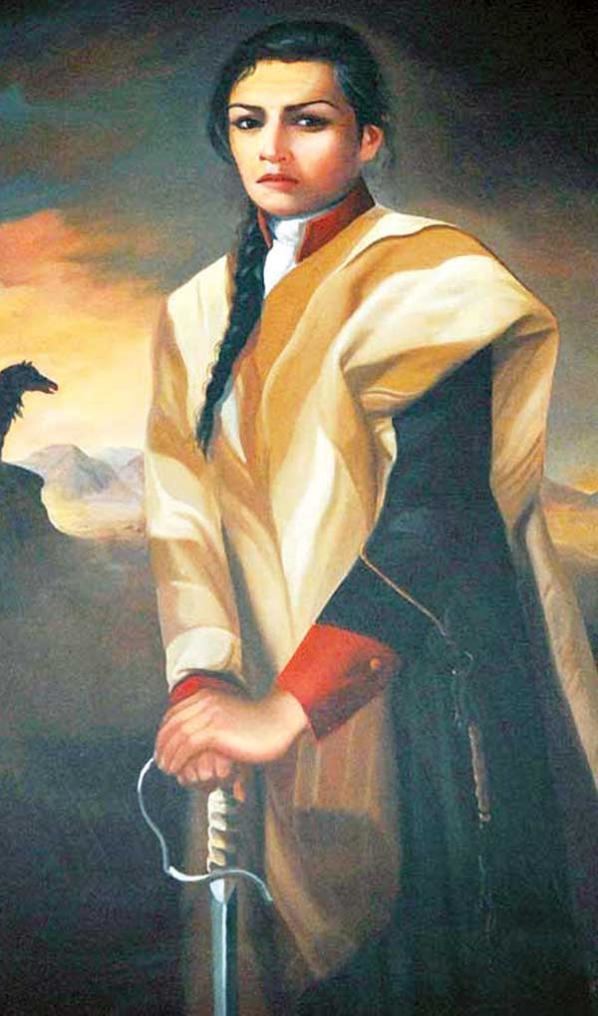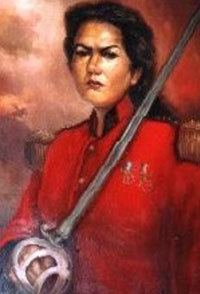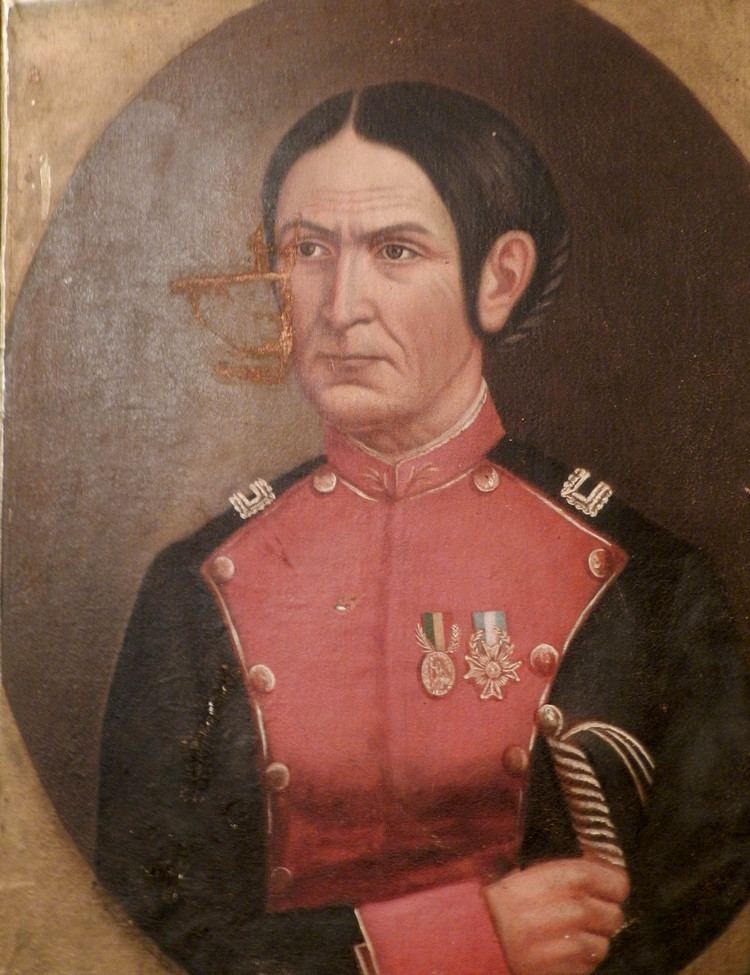Name Juana de | Died 1862, Sucre, Bolivia | |
 | ||
Spouse Manuel Ascencio Padilla (m. 1805–1816) Siblings Rosalia Azurduy Bermudez, Blas Azurduy Bermudes Children Luisa Padilla, Manuel Padilla Azurduy, Mariano Padilla Azurduy Parents Eulalia Bermudes, Matias Azurduy Similar People Manuel Ascencio Padilla, Martin Miguel de Guemes, Violeta Parra | ||
Juana azurduy de padilla historia 20100606 140517 mpg
Juana Azurduy Llanos (July 12, 1780 – May 25, 1862) was a Bolivian guerrilla military leader.
Contents
- Juana azurduy de padilla historia 20100606 140517 mpg
- Early life
- Military life and career
- Later life
- In historical memory
- References

She was born on July 12, 1780 in the town of Chuquisaca, Viceroyalty of the Río de la Plata (now Sucre, Bolivia). She was Mestiza by ethnicity, meaning she had both Spanish and indigenous ancestry. “Her mother married into a family of property” meaning she married into a more wealthy family. Her father, however, was killed by Spaniards, and the killer apparently got away without any repercussions. She grew up in Chuquisaca and at the age of 12 joined a convent to become a nun. She was then expelled at the age of 17 because she rebelled too often. She married Manuel Ascencio Padilla in 1805, a man who shared her love of the indigenous populations in Bolivia. She spoke Spanish and two South American languages: Quechua and Aymara.

Early life

Juana Azurduy was born in Toroca, a town located in the Municipality of Potosí in the Viceroyalty of the Río de la Plata (present-day town of Ravelo, Potosí Department, Bolivia) on July 12, 1780. Her parents were Don Matías Azurduy, a rich white owner of many properties and Doña Eulalia Bermudes, a chola from Chuquisaca. She was baptized in La Plata (present-day Sucre, Chuqisaca) . She grew up in Chuquisaca and began her education at the age of 12 in the prestigious Convento de Santa Teresa de Chuquisaca to become a nun and spoke Spanish as well as Quechua. Due to her rebellious temperament, she was expelled from the convent at the age of 17.

In 1805, at the age of 25, Juana married Manuel Ascencio Padilla.
Military life and career

Azurduy and her husband joined the Chuquisaca Revolution, which on May 25, 1809 dismissed the president of the Real Audencia of Charcas, Ramón García de León y Pizarro. This uprising ended in 1810 when the revolutionaries were defeated by the royalist troops which the viceroy of the Viceroyalty of the Río de la Plata, Baltasar Hidalgo de Cisneros, sent under the command of Brigadier Vicente Nieto. At the conclusion, the ringleaders were condemned to prison and exile.

In 1811, the Padilla couple joined the Army of the North, sent from Buenos Aires to fight the royalists of Upper Peru and received the revolutionary chiefs Juan José Castelli, Antonio González Balcarce and Eustoquio Díaz Vélez in the haciendas of Yaipiri and Yurubamba.

With the defeat of the patriot forces in the Battle of Huaqui on June 20, 1811, the army of the Viceroyalty of Peru, under the command of José Manuel de Goyeneche, recovered the control of Upper Peru. The properties of the Padillas, together with the harvest and their profits, were confiscated; likewise, Juana Azurduy and her four sons were seized, though Padilla managed to rescue them, taking refuge in the heights of Tarabuco.
In 1812 Padilla and Juana Azurduy served under General Manuel Belgrano, the new head of the Army of the North, arriving to recruit 10,000 militiamen. During the Jujuy Exodus, they collaborated with the rear guard commanded by the major general Díaz Vélez.
The popular entrance of Díaz Vélez in Potosí, on May 17, 1813, allowed Juana Azurduy and her family to reunite with Padilla.
Azurduy then organized the "Loyal Battalions" which participated in the Battle of Ayohuma on November 9, 1813, a new defeat that meant the temporary retreat of the Rio Plata Army of Upper Peru. From this time, Padilla and his militiamen dedicated themselves to realize guerilla actions against the Royalists.
On March 3, 1816, near Villa, Bolivia, Juana Azurduy led 30 cavalry, among them women, to attack the La Hera Spanish forces, took their standard, and obtained rifles.
On March 8, 1816, her forces temporarily captured the Cerro Rico of Potosí, the main source of Spanish silver, also leading a cavalry charge that resulted in the capture of the enemy standard. For these actions she was promoted to Lieutenant Colonel on August 16, 1816, by Juan Martín de Pueyrredón, the Supreme Director of the United Provinces of the Río de la Plata at Buenos Aires.
During the Battle of La Laguna on November 14, 1816, Juana, who was expecting her fifth child, was injured, and her husband was killed while trying to rescue her. The body of her husband was hanged by the Royalists in the village of Laguna, and Juana found herself in a desperate situation: single, pregnant and with Royalist armies effectively controlling the territory. With the death of Padilla, the northern guerilla forces dissolved, and Juana was forced to survive in the region of Salta. She led a counterattack to recover the body of her husband, but when the Spanish counter-attacked in 1818, she was forced to flee again with her soldiers to Northern Argentina where she continued to fight under the command of the Argentinean governor/guerrilla leader, General Martín Miguel de Güemes. She was appointed to the position of commander of patriotic Northern Army of the Revolutionary Government of the United Provinces of the Rio de la Plata. With this army she was able to establish an insurrection zone, until the Spanish forces withdrew from the area. She was so determined to the cause that she actually fought while she was pregnant, at one point, giving birth to her daughter, then returned to the fight soon after. At the highest point of her control, she commanded an army with an estimated strength of 6,000 men.
Later life
Upon the death of Güemes in 1821, she returned to Sucre (Chuquisaca) and was reduced to poverty. In 1825 the liberator Simón Bolívar, after visiting her and seeing the miserable conditions she was living in, was embarrassed, and promoted her to the rank of Colonel and provided her with a pension. After the visit he commented to Marshal Antonio José de Sucre: "This country should not be named Bolivia in my honor, but Padilla or Azurduy, because it was they who made it free."
Azurduy stayed for some years in Salta, petitioning the Bolivian govenrnment for her confiscated goods. The pension granted to her was taken away in 1857 under the government of José María Linares. She died impoverished on May 25, 1862 at the age of 82, and was buried in a communal grave.
In historical memory
At the time of her death, she was forgotten and in poverty, but was remembered as a hero only a century later. Her remains were exhumed 100 years later and were deposited in a mausoleum constructed in her honor in the city of Sucre.
She was awarded the rank of general of the Argentine Army in 2009. She also has “The National Programme for Women's Rights and Participation” of Argentina is also named after her.
A 25-ton, 52-foot-high statue of Azurduy was created in Buenos Aires and unveiled July 15, 2015. It was commissioned by Bolivian president Evo Morales, and placed in the space where a statue of Columbus had stood for decades, creating discontent in most of the population of Buenos Aires. As of December 2015, months after its inauguration, it showed weather damage. As from September 2017 the polemic monument will be removed and placed elsewhere.
A bas relief sculpture of Juana Azurduy was on display as part of an outdoor exhibition of famous Latin Americans on the grounds of the Pan American Union Building in Washington, DC in Spring 2014. Juana Azurduy is also the subject of a children's cartoon designed to promote knowledge of Argentine history.
